Managed WordPress: How to get started with WordPress
If you have an existing WordPress website and are migrating it to us, then you’ll have our expert team to support you with this. However, if you are starting from fresh with a brand new website then this guide may be useful to read and bookmark.
So I’ve purchased Managed WordPress hosting, what now?
We’ll email you to let you know that WordPress has been installed and set up for you.
Let’s take some time to look at the site before you get into changing it and figuring out how it all works; it’s important to see how the default WordPress theme is laid out and how it works. Consider this the test drive before you start adding all the special features.
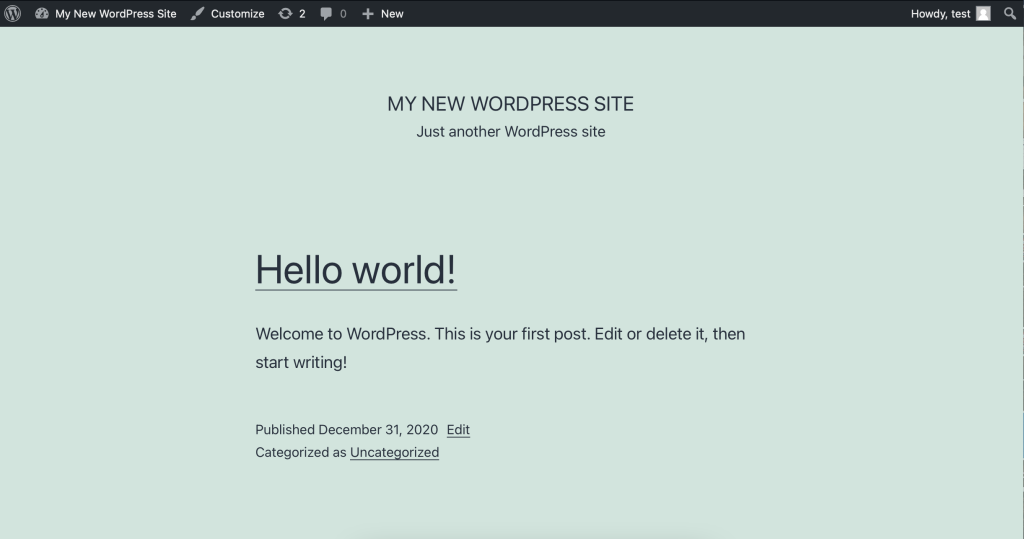
The layout you are looking at is defined by a WordPress Theme. It is the appearance of your website, styling the look of the site and the framing of the content. The WordPress Twenty Twenty-One theme as shown here features a “header” at the top with the title and tagline for your site. Below is your Menu, if you have one. The main middle section of the page is the content area.
Scroll down the page and you will see a search box, recent posts and recent comments. These are called Widgets.
Notice the bar at the end of the page. This is called the “footer.” It says “Proudly powered by WordPress.”
Take a look around.
For now you only have one post. It is residing within a page that is laid out as your home page or the front page. If you click on the title of the post, it will take you to the specific page for that post. The first page or home page of your site features the most recent posts on your site. Each post title will link to the actual page of the post. Some Theme designers design their single post pages to look different from the home page.
In the single post, pay attention to the layout and notice what is different about the design elements. Is the header different? Smaller, larger, or a different colour? Is there a sidebar?
All of these changes are created from a few files called template files. You can learn more about how they work in the WordPress Theme Developer Handbook. For now, however, let’s get on with how the rest of WordPress works.
Test drive the WordPress administration screens.
Now that you have an idea of how your site looks and what the different layout sections are called, it’s time to test drive the WordPress Administration. This is like familiarizing yourself with the backend of your new website. In fact, the first page you see after logging in is called the Dashboard, a collection of information and data about the activities and actions on your WordPress site.
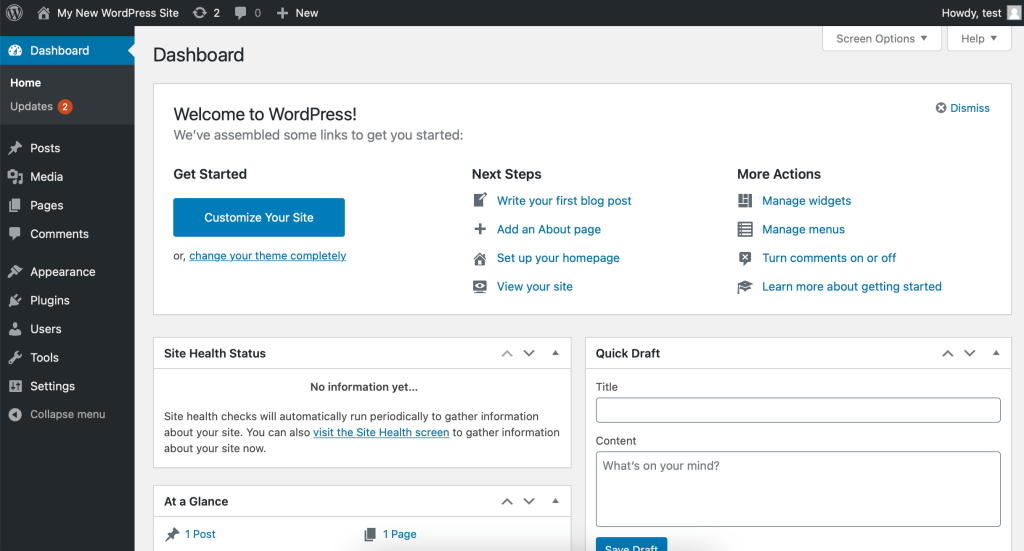
The layout you are looking at is defined by a WordPress Theme. It is the appearance of your website, styling the look of the site and the framing of the content. The WordPress Twenty Twenty-One theme as shown here features a “header” at the top with the title and tagline for your site. Below is your Menu, if you have one. The main middle section of the page is the content area.
Scroll down the page and you will see a search box, recent posts and recent comments. These are called Widgets.
Notice the bar at the end of the page. This is called the “footer.” It says “Proudly powered by WordPress.”
Take a look around.
For now you only have one post. It is residing within a page that is laid out as your home page or the front page. If you click on the title of the post, it will take you to the specific page for that post. The first page or home page of your site features the most recent posts on your site. Each post title will link to the actual page of the post. Some Theme designers design their single post pages to look different from the home page.
In the single post, pay attention to the layout and notice what is different about the design elements. Is the header different? Smaller, larger, or a different colour? Is there a sidebar?
All of these changes are created from a few files called template files. You can learn more about how they work in the WordPress Theme Developer Handbook. For now, however, let’s get on with how the rest of WordPress works.
Test drive the WordPress administration screens.
Now that you have an idea of how your site looks and what the different layout sections are called, it’s time to test drive the WordPress Administration. This is like familiarizing yourself with the backend of your new website. In fact, the first page you see after logging in is called the Dashboard, a collection of information and data about the activities and actions on your WordPress site.

The Dashboard features a list of the most recent activity you’ve accomplished on your site and it helps to keep you up to date on new and interesting bits of information from the many WordPress resources.
On the left side of the screen is the main navigation menu detailing each of the administrative functions you can perform. Move your mouse down the list and the sub-menus will “fly out” for you to move your mouse to and click. Once you choose a “parent” navigation section, it will open up to reveal the options within that section.
The various menu items are as follows:
Let’s start with the User screen.
Click on the Users tab. The screen will change and you will see the Screen called All Users that shows a list of all your users; from here you can add or change existing users and authors accounts. In the navigation menu, click on the Your Profile menu choice. This is where you will enter information about you, the author and administrator of the site. Fill in the information and click Update Profile when done.
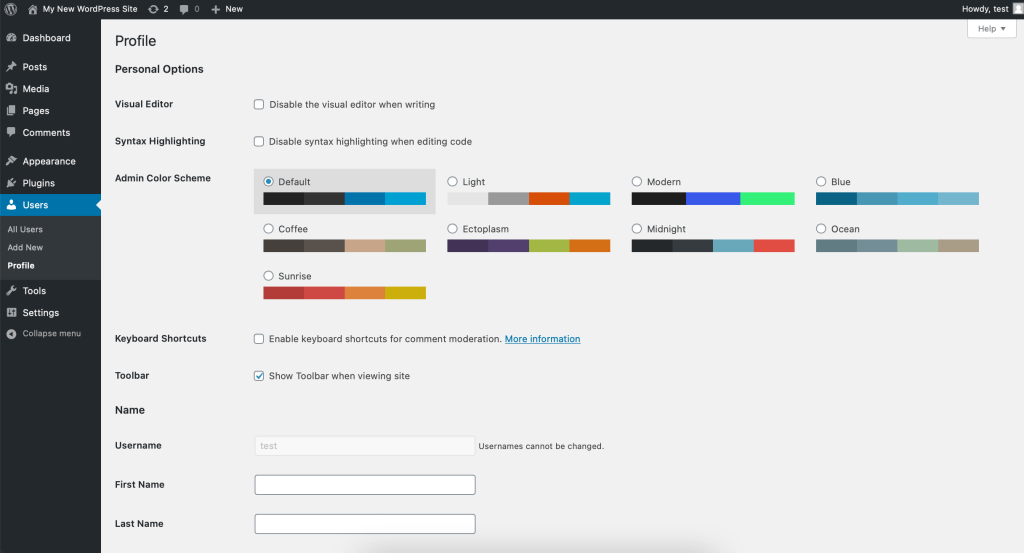
Now, let’s look at some other powerful features of the WordPress Admin.
Changing the Look.
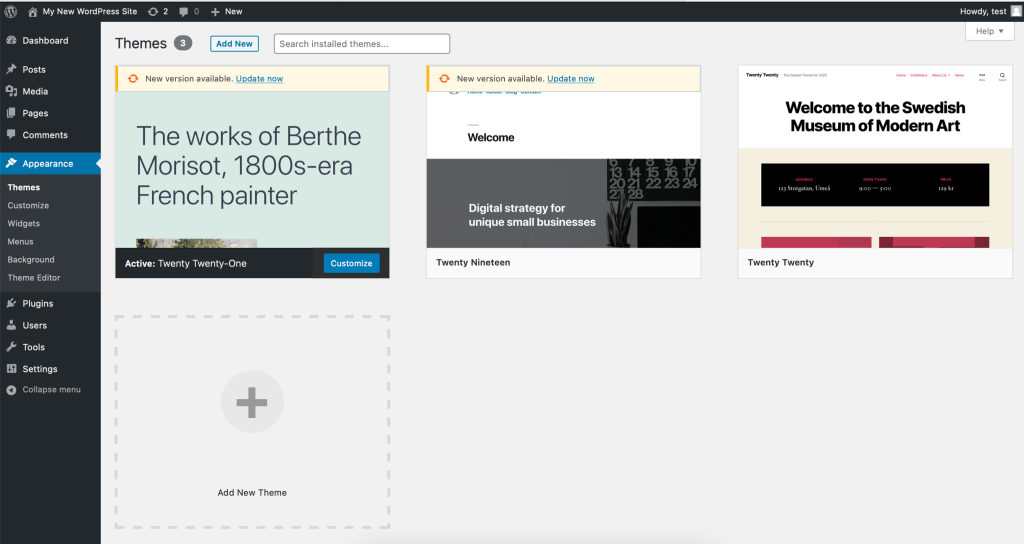
The Appearance, Themes Screen allows you to change the look of your site using different Themes. Themes are presentation styles that completely change the look of your site. Designed by developers and users, there are hundreds of themes available for you to choose from. In your Appearance Screen, you will see a list of currently installed themes, including the WordPress Twenty Twenty-One theme.
To quickly change the theme, simply click on the Activate button under one of the themes listed, then click on your site name in the top toolbar to see how it looks. Wow, you have another look. It’s that easy. Go back to Appearance > Theme and click the Activate button under the WordPress Twenty Twenty-One theme to bring the design back to what you had. To see it again, click your site name in the toolbar, and there it is.
Creating a post
Back in the Administration Screen, take a look at the Posts Screen. You can use the tabs under the Posts Menu to write and manage your posts. Let’s start by making your first test post in the Add New tab.
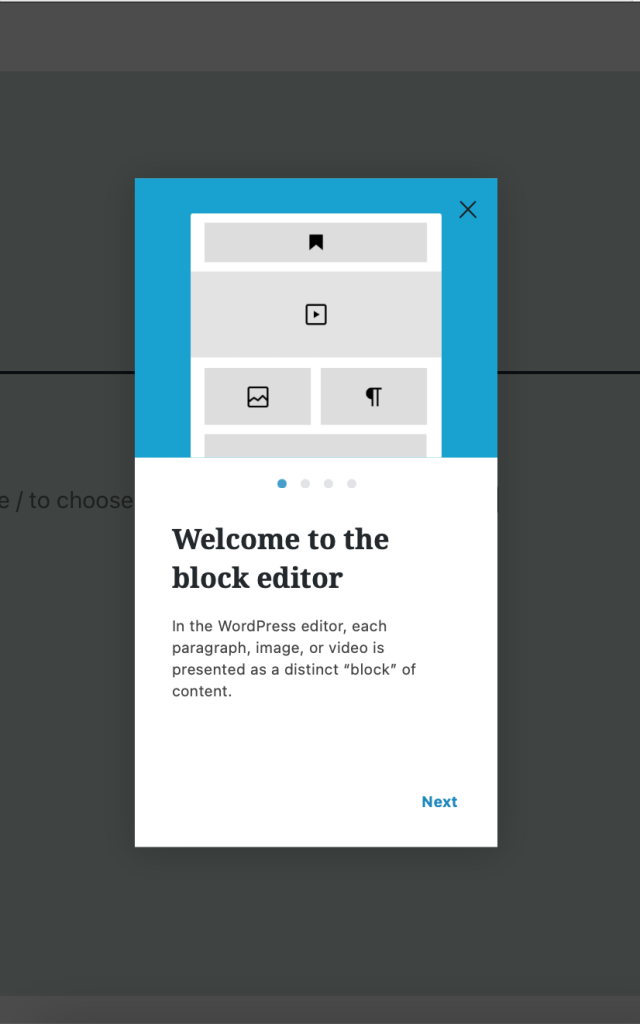
The first time you use the Block Editor, you will see a short tutorial.
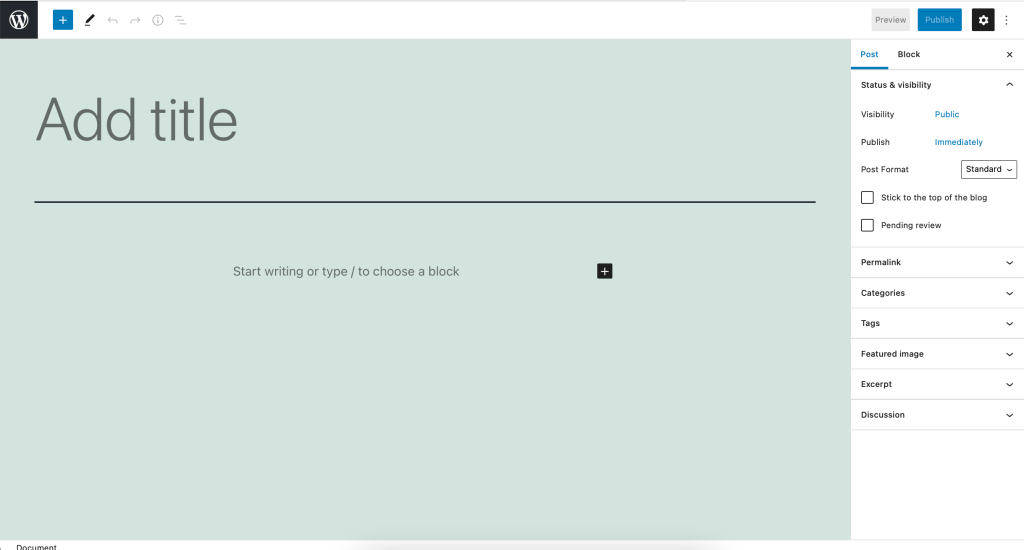
Add the title of the article in the space allocated. Then write a text in the “Start writing or type / to choose a block” section This is just for a test, so you can write anything you want. When you are done, click on the Publish button at the top right of the page, then click a second time to confirm the publication. Now that you’ve gotten a feel for writing posts, you can view your posts by clicking your site name in the toolbar at top of the screen.
Comments.
Part of the fun of WordPress is the ability to have viewers leave comments on your site. It creates a dynamic interchange between you and the viewer. Do you want comments on your posts? Comments on posts come in a variety of forms, from pats on the back (Good job! Like the post!) to extensive conversations and commentary about the posts.
Or maybe you are seeking comments that add to the information you’ve posted. Responding to comments and moderating them can also take up a lot of time. If they are critical to your site, then include them and consider how you want them presented. You can make a few comments yourself on the post you created.
Take a look at how they are laid out and consider how you might want them to look to fit into the design and layout of your site. When you have reached your decision about how you want to handle comments, take time to read through this article on comments and WordPress discussion options to help you set those features.
Preventing spam.
There is more to think about when it comes to having comments on your site. Unfortunately, we live in a world where spam is a fact of life. It is recommended that you begin battling the comment spammers with this helpful article, Introduction to Dealing with Comment Spam.
Using WordPress themes.
There are hundreds of WordPress Themes to choose from. All do basically the same thing but graphically present the information in a myriad of ways. Choose a few that look interesting to you, and meet your audience’s needs and your desires, and then test drive them following the test drive instructions above.
Click through the whole site, the categories and archives as well as the individual posts to see how the Theme handles each one. The look may be nice on the front page, but if it handles things in a way you don’t like on the single post, then you will have to dig into the code and make changes. If you’re not ready for that, try another theme.
You can see the themes that WordPress offer here: WordPress Theme Directory
Using WordPress plugins.
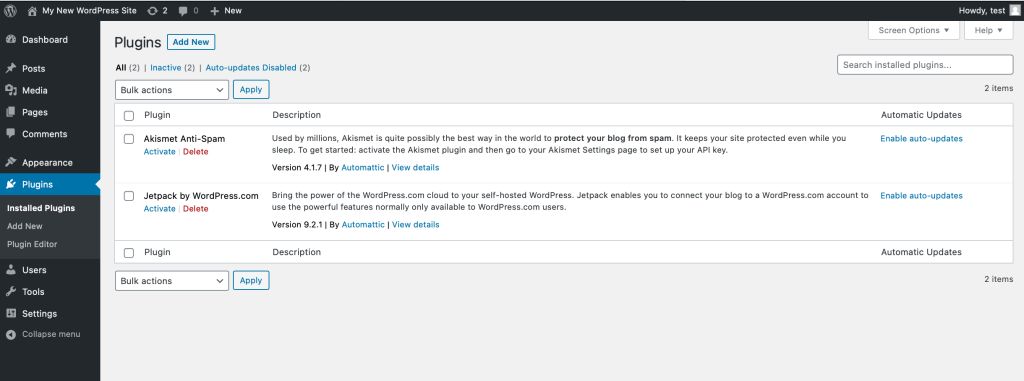
WordPress Plugins are also known as add-ons or extensions. They are software scripts that add functions and events to your website. They cover the gamut from up-to-date weather reports to a simple organization of your posts and categories. Plugins are designed by volunteer contributors and enthusiasts who like challenges and problem-solving.
They are usually fairly simple to install through the WordPress Admin Plugin Screen, just follow the instructions provided by the plugin author. Remember, these are free and non-essential. If you have any problems with plugins, contact the plugin author’s website or plugin source first, then search the Internet for help with that specific plugin, and if you haven’t found a solution, then visit the WordPress forums for more help.
You can view the plugins that are offered through WordPress here: WordPress Plugin Directory
The exciting thing about WordPress is that there are few limits. Thousands of people are using WordPress for blogging and for running their websites. For example, look at some of the entries under the WordPress.org Theme Showcase. All have a different look and different functions on their sites. What you do from here is up to you.
Happy Blogging!
New to creating a WordPress website?
Don’t stress – our FREE WordPress for Beginners e-Book will help you create a beautiful, functional website from scratch. From installation to publishing, we’ll guide you through each step. You’ll learn about WordPress themes and plugins, how to create your first post or page, how to activate your SSL Certificate and optimise your website for search engines.

